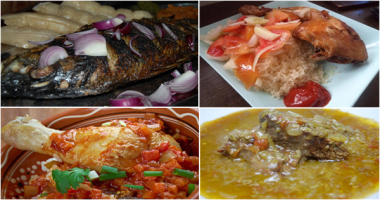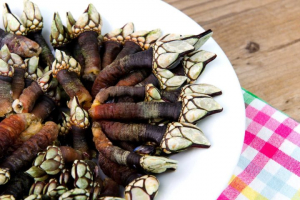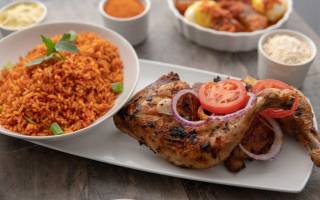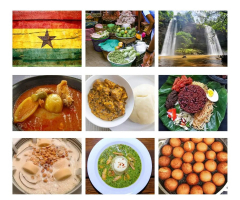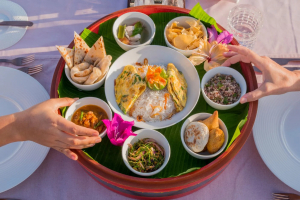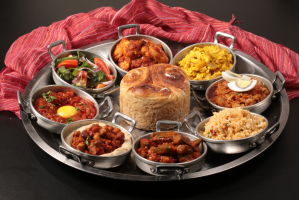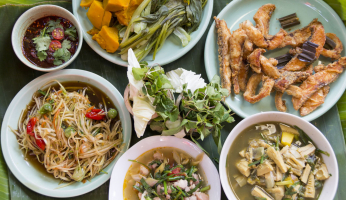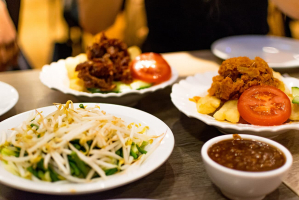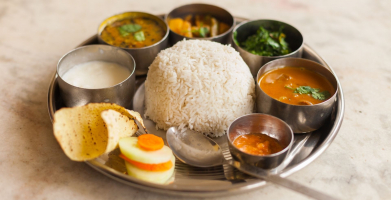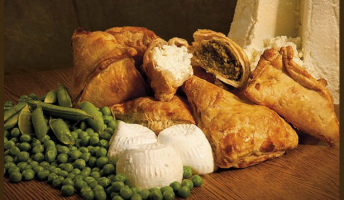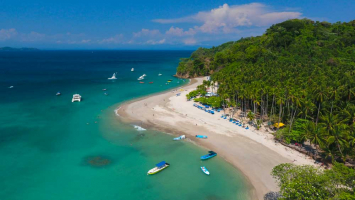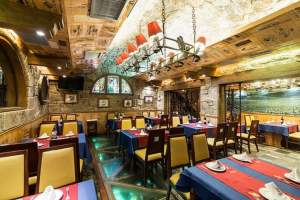Top 12 Venezuela's Speciality Foods
Venezuelan cuisine is a synthesis of several cuisines and is influenced by a wide range of cultures, including West African, Native American, Italian, Spanish, ... read more...Portuguese, and French. Venezuelan cuisine, with its stimulating spices, unusual tastes, and delicious sweet dishes, has become a global favorite. Here is a list of dishes you must try when coming to Venezuela.
-
Pabellón criollo is a popular Venezuelan meal that is the Caribbean's equivalent of the rice and beans combo. It consists of rice, stewed shredded beef, and stewed black beans.
Tajadas (fried plantain slices) and fried eggs are popular additions, and both have earned slang titles. A pabellón with barandas (guard rail in Spanish) is served with tajadas because the long plantain slices put on the edges are said to protect the meal from slipping off the dish. A pabellón a caballo is a dish with a fried egg on top, as if the egg were "riding" the dish. Aside from these two primary variations, people also add other ingredients to the meal, such as granulated sugar on the beans, Queso Palmita over the beans, or spicy sauce on the meat.
Depending on the locale, time of year (beef intake is banned by the Roman Catholic Church during Lent; however, capybara and fish are permitted), or personal preference, the shredded beef can be changed with chigüire, shredded caiman meat, or even freshwater fish.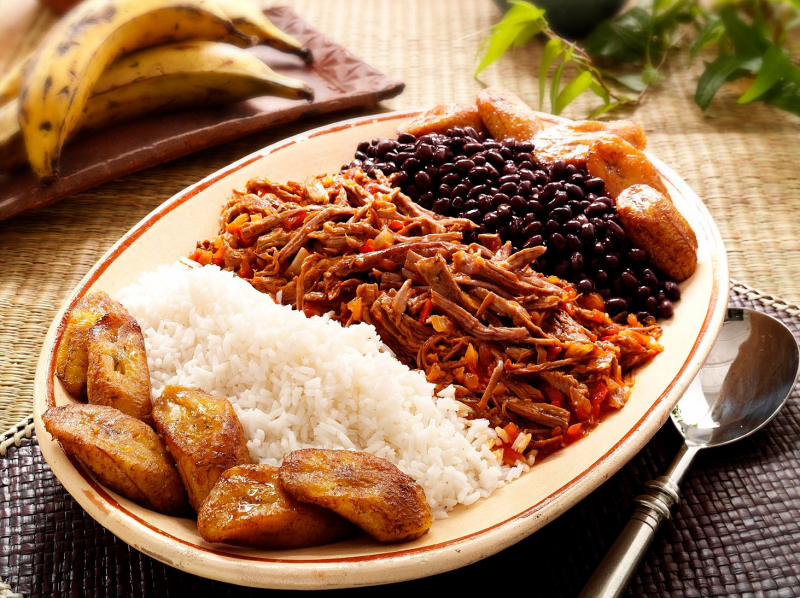
Source: Goya Foods Source: Cocina al Natural -
Hallaca is a classic Venezuelan dish that resembles (for comparative purposes only) a tamal in appearance. The hallaca and tamal, on the other hand, differ in flavor, texture, ingredients, and cultural importance. It's made of maize bread that's been stuffed with a beef, pig, or chicken stew and other ingredients including raisins, capers, and olives, fresh onion rings, and red and green bell pepper slices. There are also vegetarian choices, such as black beans or tofu. Hallacas are cooked after being wrapped in plantain leaves and tied with strings. The meal is commonly served during the Christmas season and has numerous regional variations in Venezuela. It has been regarded as a Venezuelan national food, however there are variations. Some believe it originated in the Orinoquia. The delicate maize dough cooked with consommé or broth and lard tinted with annatto is a hallmark of the hallaca. Hallacas are also popular in eastern Cuba, Trinidad (where it is known as pastelle), and areas of Colombia, Ecuador, Aruba, and Curaçao. It is known as "Nacatamal" in Nicaragua.
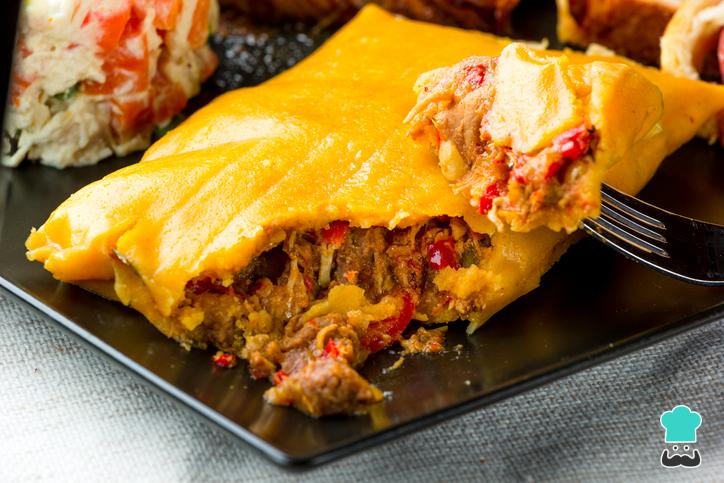
Source: Tasty -
According to Miro Popi, a Venezuelan writer and pundit specializing in food, Gustavo Ramella, the owner of a bakery in Caracas, invented the recipe of Pan de jamón in December 1905. Apparently, the original bread was solely stuffed with ham. Other well-known bakeries began manufacturing the bread and added other components. By 1920, the filling had been enriched with olives, nuts, and capers.
Pan de jamón (ham bread) is a traditional Christmas bread in Venezuela, filled with ham, raisins, and green olives. Many versions have been developed, with some utilizing puff pastry as the dough and others filling the bread with various things such as turkey or cream cheese. Pan de jamón first arose in the early twentieth century and gradually became a Christmas custom in Venezuela and Madeira.
Pan de jamón is a soft loaf of bread. It contains sugar, which gives the dough a sweet flavor. To make it, put the dough on a flat surface and top with ham pieces, olives, and raisins. It is then rolled and cooked. The scent and flavor are wonderful once cooked
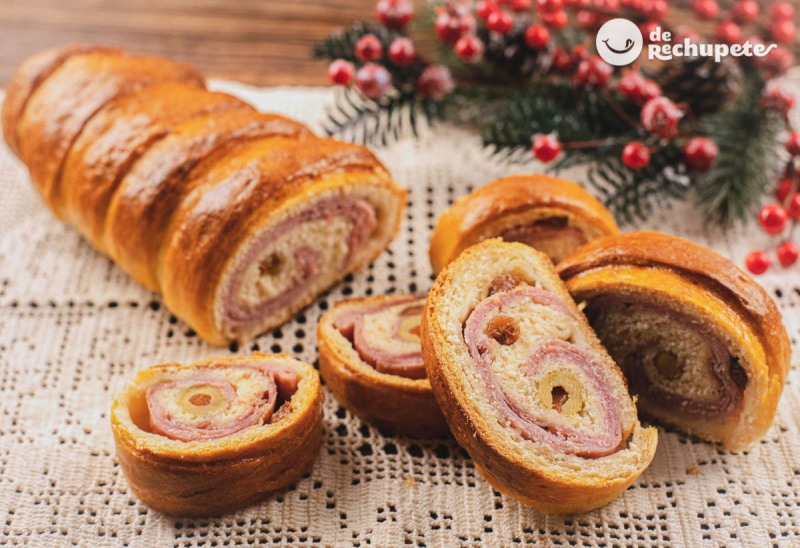
Source: Recetas de rechupete Source: Temperos e Sabores -
Bollos pelones are difficult to resist. It's a veritable burst of flavors on your tongue. They're popular all year for a variety of reasons, including the fact that they're a complete lunch meal, and two or three bollos pelones will serve. It's also a quick and easy dish to cook, taking less than an hour. The most important requirement, however, is that both children and adults appreciate this dish and find it satisfying.
There is also a version prepared with maize flour dyed with onoto, which is used for hallacas. The balls (about the size of a huge apple) are stuffed with beef or chicken stew and boiled until done. There is no sauce in this situation. The stew must be prepared ahead of time. It is commonly served with rice, although it can also be eaten on its own. Another variation includes cooked and liquefied pumpkin added into the dough. On the island of Margarita, it is often prepared in this manner, packed with fish stew (generally dogfish or skate).
Bollo pelón is a maize dough ball filled with beef stew, although it can also be filled with chicken stew. The bollos pelones are then cooked and served with a delicious tomato sauce and grated cheese. Unfortunately, they are not commonly provided in restaurants.
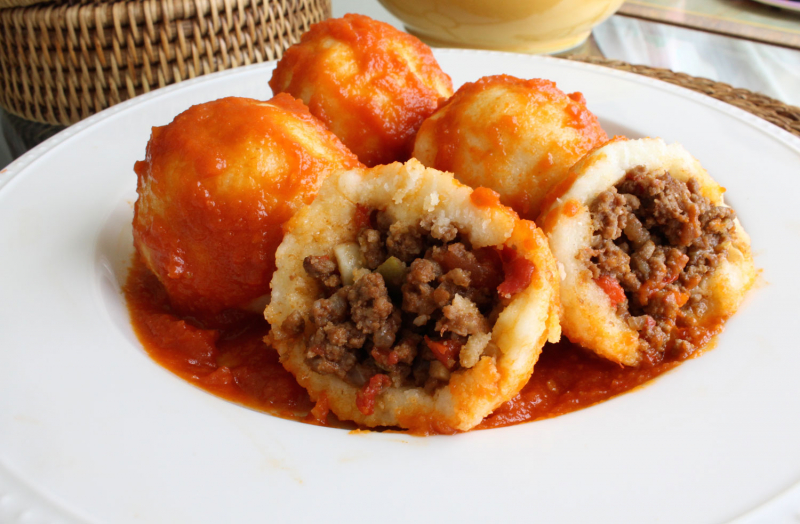
Source: Hispanic Kitchen Source: ScarlettMiau -
The Pisca Andina is a popular traditional meal in the Venezuelan Andes. A soup made with chicken broth and potatoes, topped with a poached egg and loads of cilantro. This meal is offered at breakfast, which may surprise you. Locals in the coldest areas of the highlands believe that starting the day with a soup to warm up your body is the best approach to go about your daily tasks. Pisca andean is a basic soup or broth made with coriander, chives, and water, as well as diced potatoes, egg, and milk. Pisca andean is indigenous to Venezuela's Andes and is usually served during breakfast. It is generally served with wheat or maize arepas. Potatoes, imported directly from the Andean region of excellent quality, are a special element in the preparation.
This soup has a basic recipe that is centered on coriander and green onion, which give it a distinct and outstanding scent. Despite this, the potatoes, eggs, and milk give it a smooth and delicate flavor. It's traditionally served with Andino bread and white cheese. Chili is one of the varieties, which is great for those who enjoy hot foods. Pisca Andina has become a part of Venezuela's cultural heritage.
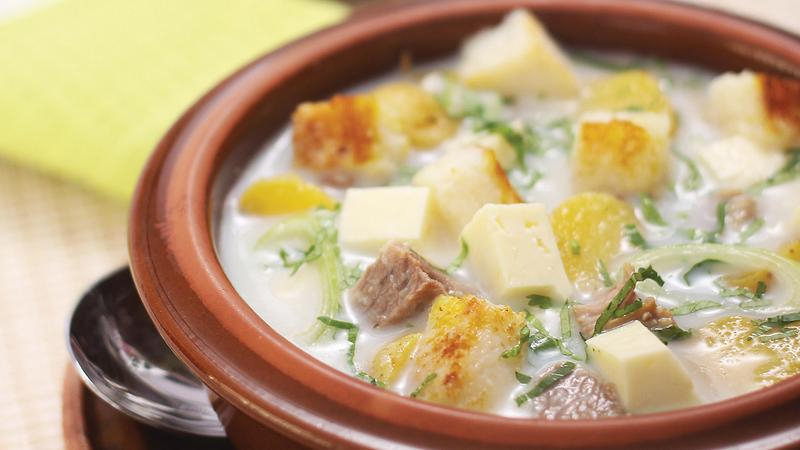
Source: World Food Guide Source: Cuina per tu! -
Patacón is a popular side dish in many Latin American and Caribbean nations. This Patacón zuliano or Venezuelan Patacon is widely found at practically every food cart and in most small eateries. That's a sandwich prepared using Patacón, a twice-fried green plantain, instead of bread!
This Venezuelan speciality is served between two crispy fried green plantain pieces. People put shredded meat or chicken, salad, grated cheese, boiled eggs, occasionally veggies, and a lot of mayonnaise and ketchup in the middle. The zulian patacon differs from tostones and patacones found elsewhere in the nation and in the Caribbean. Patacón Maracucho is another name for it.
The cuisine originates in the city of Maracaibo, Zulia, where there are food establishments specializing in this sort of preparation. There are innumerable street food booths providing Fried Plantain Sandwich (Patacón Maracucho), and one is believed to be better than the next.
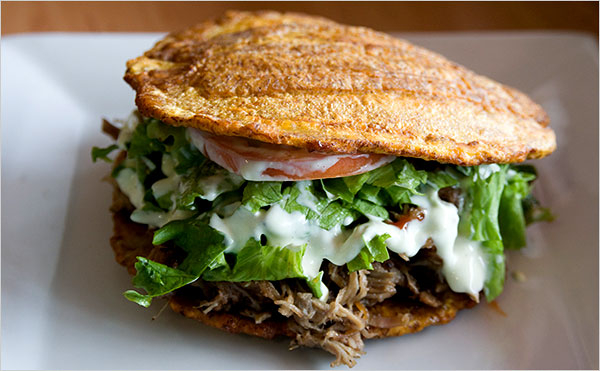
Source: The New York Times Source: Recetas Venezolanas -
Tequeños is a typical Venezuelan dish or snack that consists of a fried breaded cheese stick or a spear of bread dough with queso blanco (fresh cheese) inserted in the centre. To make it, the dough is wrapped around a cheesestick and molded into a breadstick, which can then be fried in oil or baked in the oven. Tequeños can be eaten at breakfast, as a side appetizer, or as a party or wedding snack.
Tequeños are indigenous to Northern South America. There are several ideas and traditions surrounding the origin of the word Tequeños, including the belief that they were named after Los Teques because they were made in the kitchen of one of the affluent families that lived there.
Many various Tequeños recipes may be found online. Tequeños can be created with a variety of cheeses, as well as sweet fillings such as chocolate or guava, however salty white cheeses are the most popular. Tequeños have grown in popularity throughout Latin America as a result of its ease of preparation, due to the Venezuelan diaspora. They have also grown in popularity in Spain. Similar meals exist, such as Peruvian Tequeños, which employ a Wantán dough and can include ingredients other than cheese. They are frequently served with Guacamole.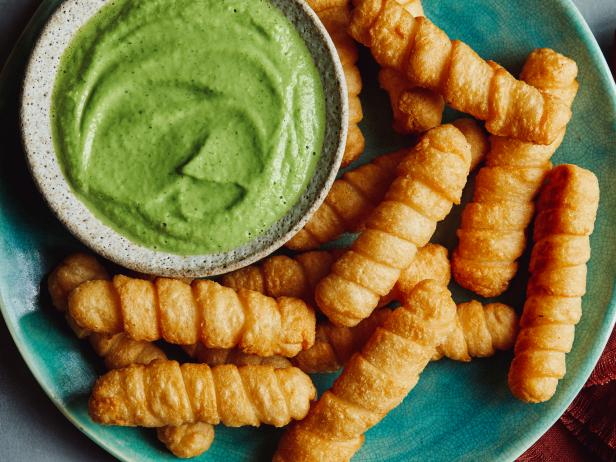
Source: Food Network Source: Cocina Para Todos -
A mandoca is a Venezuelan deep-fried cornmeal ring that is typically eaten while still hot with butter, cheese, and coffee. It is often eaten for breakfast and is especially popular in the country's Zulia state. The mandoca is one of a number of specializations established solely in the western state of Zulia.
Though their importance has been diminished by new international inclinations since their development was not meant for mass consumption or marketing, it remains a fundamental and vital aspect of Zulia's culinary culture. It's made with cornmeal, water, salt, grated "queso blanco" (hard, salty, white cheese), sugar or panela (jaggery, which is used in most traditional recipes), and extremely ripe plantain.
Children adore them, and moms frequently prepare Mandocas for their children to eat as a snack or breakfast at school. The corn dough contains various delicious and particularly indigenous components, including extremely ripe mashed plantains, anise seeds, grated cheese, and raw cane sugar. The latter is magical because when cooked, it turns the dough sweet and dark brown. All of these ingredients are combined in a bowl, kneaded, formed into a horseshoe, and then cooked in a large amount of oil. Despite their unhealthiness, they are delicious!
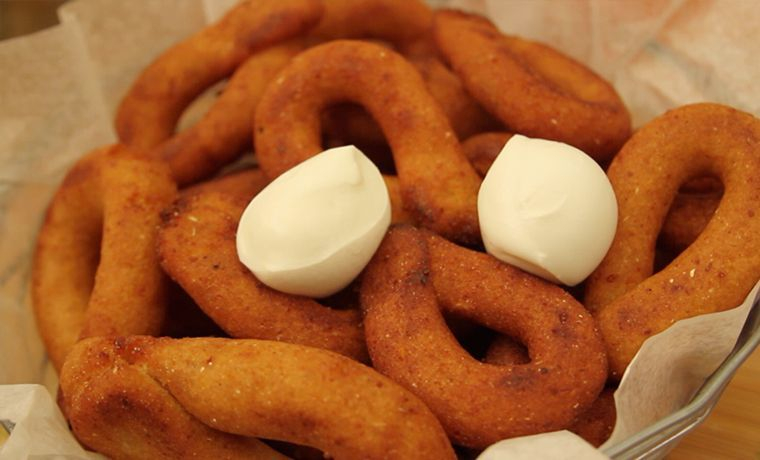
Source: El Diario Habla Source: ScarlettMiau -
Venezuelan Fosforera soup is a traditional meal from the country's eastern coast. Because of the large range of marine elements included in this dish, it is said to have aphrodisiac properties. The Venezuelan shellfish matchstick has a high nutritional value, which is why it is supposed to "raise even a dead person" in Venezuela. Its preparation is time-consuming yet straightforward, and the payoff is well worth it.
This soup's name, fosforera, is said to be derived from phosphorus, as it is unusually high in this nutrient. Fish head, shrimps, clams, squids, and crabs are among the items used in a fosforera soup. Aside from seafood, it also incorporates diverse veggies such as onions, tomatoes, sweet chili, and coriander.
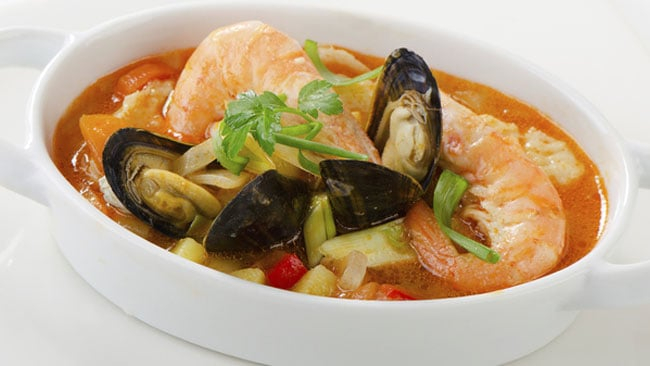
Source: Receta Venezolana Source: Temperos e Sabores -
Crunchy on the surface, soft on the inside, and all-around tasty! Bunuelos are maybe the most delectable yucca snack. They're not as prevalent as they formerly were. Grandmas normally prepare these for the family, although you may still see them during Easter and Christmas. When the sweet honey adheres to your palette, the salty cheese provides an excellent contrast to the sweetness. The recipe is easy, and it will take you around 40 minutes to create them. You'll need yucca, cheese to stuff the balls, raw cane sugar to color the dough, and honey to drizzle on top of the fried Buueos.
The most well-known fritter recipes are those made with cassava, which are crispy on the top and very soft on the interior; they were formerly prepared with sweet potato, pumpkin, and celery... They are the monarchs of the cassava fritters, although they are closely followed by celery and sweet potato.
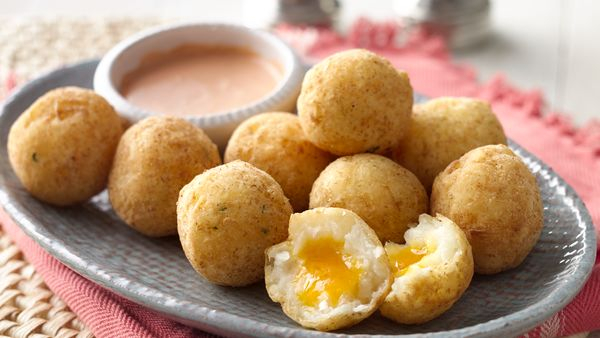
Source: QueRicaVida.com Source: Anonima Venezolana -
This cake or biscuit is known by many names in different parts of Venezuela, but the recipe is fundamentally the same. Paledonias are distinguished from conventional cakes by their dark color. People use raw cane sugar instead of regular sugar to achieve the desired hue.
Paledonias is a Venezuelan delicacy that is most abundant in the Andes and western areas. Paledonias are half cake and half cookie, with a soft and pleasant texture and a sweet flavour that coats your taste receptors right away. Paledonias are made using flour, maple syrup, cinnamon, and a blob of unrefined cane sugar. The sugar is what gives Paledonias its distinctive brown hue and soft yet crunchy surface. While the inside resembles a sponge cake. Paledonias are delicious as a dessert, but they are also popular as a snack or at breakfast, where they are served with coffee and milk. Something you should try at least once when traveling.
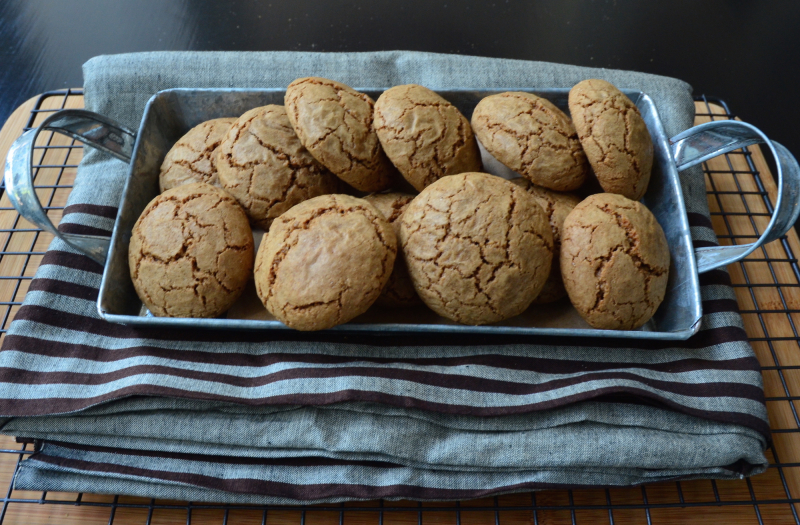
Source: cookie companion Source: Temperos e Sabores -
The controversy concerning the origins of arepas continues. Is it Venezuelan or Colombian? But question the locals and explore the country's food scene, and you'll quickly realize that arepas are associated with Venezuelan cuisine. After all, there's nothing more Venezuelan than an arepa, as the expression goes. Arepas are one of the easiest Venezuelan dishes to prepare at home. While you'll surely fall in love with the doughy dish while traveling, its versatility makes it a culinary favorite. Arepas are produced using an unleavened maize flour dough that is stretched flat and circular over the bench. After filling it with anything you like, you may bake, broil, or fry it.
Traditional arepas differ around the country, based on the chef's approach and the ingredients available. Typical stuffings, on the other hand, include black beans, scrambled eggs, and cheese, which is ideal for a late brunch meal. For a healthy lunch, try seasoned ground beef and shredded carrots. You could also add avocado, flax seeds, or oats to your own arepas to keep them light and healthful.
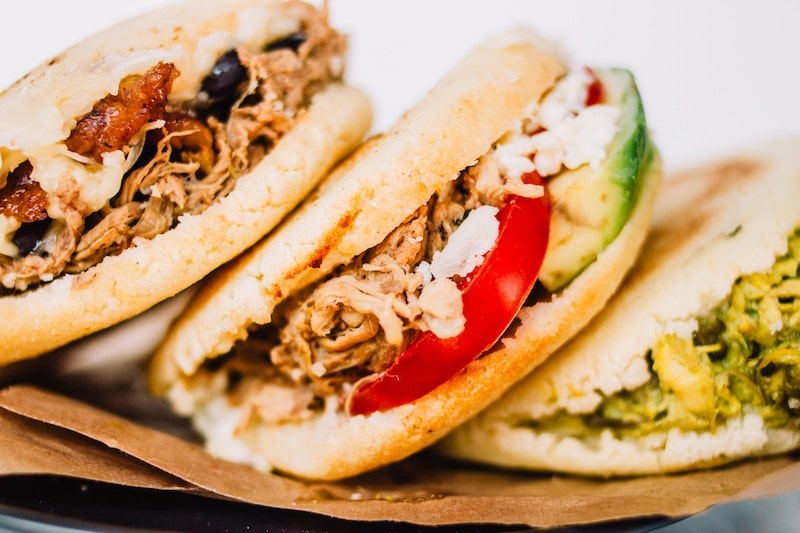
Source: Pequeocio Source: • Juan Pedro Cocina •














